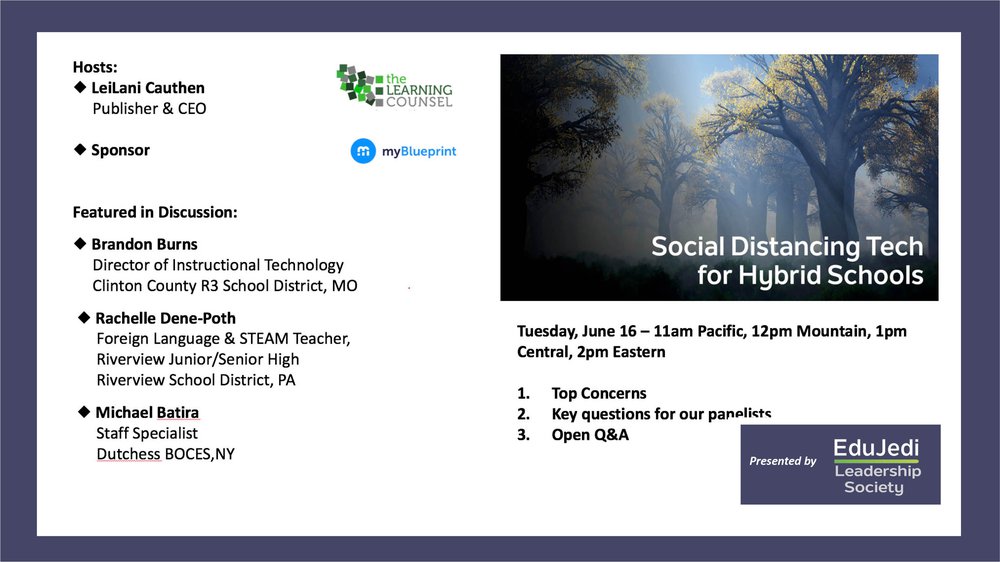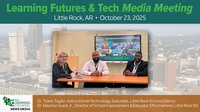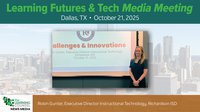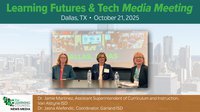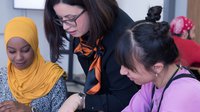One of the most difficult aspects of our return to physical school is the question of proper social distancing. Even with a hybrid model of learning, the implications of student safety are massive, as is the planning needed to accomplish it. In this episode of the Learning Counsel’s Dawn of New Strategies series, school, district and BOCES leaders grapple with the tech needed to pull it off.
According to LeiLani Cauthen, CEO and Publisher at the Learning Counsel, “When we're talking about social distancing, we're normally talking to schools who are now moving into a hybrid mode. That has many different definitions. It typically means kids are not on campus all the time, or you need to be ready to have them remote at any time if there's a second wave of coronavirus. The top concerns from our research are number one, the scheduling, an auto calendaring or auto scheduling and calendaring, how that's all going to work. Then there's the issue of classrooms. Spacing, keeping kids far enough apart - there's discussion between six feet and eight feet, sometimes 10 feet apart, which really wrecks your normal total numbers of kids per classroom and gets kind of wild. There's transportation distancing, how many kids can you fit on a bus? There are issues with recess and sports. And then sanitizing, how you're going to sanitize the entire school and keep it sanitized. And then the issues of whole child education.”
Brandon Burns is the Director of Instructional Technology at Clinton County R3 School District in Missouri. Burns said, “It doesn't make a lot of sense for us to run a thousand miles ahead and try to set the tone for everyone when we haven't received a clear recommendation from the state yet. So, we're coming up with some of our priorities and putting some things in place to make sure that we're able to, to target those. We have not put out our plan for returning in the fall yet because we really need to see what the state is going to recommend and then how we can build on that.”
Rachelle Dene Poth, Foreign Language and STEAM Teacher at Riverview Junior/Senior High at Riverview School District in Pennsylvania said, “I have not been back in my classroom. I'm hoping to get back there in July to do some cleaning up and to assess and hopefully know what the fall might look like. A lot of it is just waiting to see what else happens over the next couple of weeks and months. And what comes from the state as far as the requirements about the social distancing.
“As the year ended, we had some professional development days where all teachers were getting trained on using Microsoft and Microsoft Teams. And then we had a day where teachers could choose based on a list of different options. We also had training for career and college and awareness with the program that we use in our school district. We are trying to give everybody the opportunity to learn at the same time and to have an opportunity to ask questions so that we can all have a system to start with in the Fall, regardless if we're in our physical classrooms or if we're distanced or if it's going to be a mix.”
Michael Batira is a Staff Specialist at the Dutchess BOCES in New York. According to Batira, “Since we are a BOCES, which is a cooperative for New York State, we are working with the 13 components. We are looking at the governance through New York State. And we're being told, understandably, that there are phases that we are working through - a total of four and they apply to different regions. There are 10 regions in New York State. What we're doing is looking at the guidance that's coming from state ed. In terms of the guidance as to what we're going to do moving forward, we are largely dependent upon additional trainings for the summer, both for federal and state funding and keeping those people involved and aware of that. And at the same time, being a support for the community. That's what we do. We're focused on bridging those district-wide gaps that might be existing in the community. And our cost savings are focused on providing those tool sets for professional development, special ed, soft skill enhancement and equity technology.”
Brandon Burns from Clinton County R3 School District added, “I was part of a design thinking challenge for students last week. There were about 15 teams that were tasked with coming up with solving the problem of education for the upcoming Fall. They were all students, some college, some high school. Almost a third of the recommendations from the kids as to how to fix this pointed straight towards auto scheduling and calendaring and how difficult it was to follow a plan when you had multiple teachers that were setting up events that were stacked on top of each other and created conflicts that the student either had to make a choice or just not attend and try to catch up afterwards.”
As LeiLani Cauthen states, “It's really all up in the air right now, but the fact is there's no one in education is immune from trying to plan for every scenario at the teacher level all the way up.”
Watch the video
It is evident that everything is on the table right now when it comes to creating a hybrid learning plan that allows for social distancing. Plans are still being formed, and the complexity can seem overwhelming. If you want some good ideas for your school or district, be sure to watch this discussion.
About our sponsor
myBlueprint allows you to engage your students in their educational journey with a
digital portfolio tool that meets them where they are, whether at home or in class, or a combination of the two. With myBlueprint, teachers can:
- Post and share student learning as it happens, on any device
- Comment and message students to give real-time feedback
- See students’ progress in class over time

